The Stable Carbon Isotope Composition of Pinus yunnanensis Pollen and Leaf in Northwestern Yunnan, China
Abstract
1. Introduction
2. Materials and Methods
2.1. Regional Setting
2.2. Sampling, Stable Isotope Analysis, and Data Processing
3. Results
4. Discussion
4.1. Isotopic Differences between Pollen and Leaf δ13C of Pinus yunnanensis
4.2. Factors Affecting Pinus yunnanensis Pollen and Leaf δ13C Values
5. Conclusions
- (1)
- A marked difference occurs between the pollen and leaf δ13C values, indicating an isotope fractionation between the two tissues.
- (2)
- A statistically significant negative correlation between the pollen δ13C values and the altitudes of the sampling sites, and no significant correlation between the leaf δ13C values and altitudes, suggesting that pollen may be more sensitive to some climatic parameters than leaf.
- (3)
- The pollen and leaf δ13C values of Pinus yunnanensis have the lowest values among the Pinus species and the other genus species of Pinaceae with the available δ13C values of the two tissues, implying the effects of the water availability on the pollen and leaf δ13C values, especially pollen.
Author Contributions
Funding
Data Availability Statement
Acknowledgments
Conflicts of Interest
References
- Dawson, T.E.; Mambelli, S.; Plamboeck, A.H.; Templer, P.H.; Tu, K.P. Stable isotopes in plant ecology. Annu. Rev. Ecol. Syst. 2002, 33, 507–559. [Google Scholar] [CrossRef]
- West, J.B.; Bowen, G.J.; Cerling, T.E.; Ehleringer, J.R. Stable isotopes as one of nature’s ecological recorders. Trends Ecol. Evol. 2006, 21, 408–414. [Google Scholar] [CrossRef] [PubMed]
- Werner, C.; Schnyder, H.; Cuntz, M.; Keitel, C.; Zeeman, M.J.; Dawson, T.E.; Badeck, F.-W.; Brugnoli, E.; Ghashghaie, J.; Grams, T.E.E.; et al. Progress and challenges in using stable isotopes to trace plant carbon and water relations across scales. Biogeosciences 2012, 9, 3083–3111. [Google Scholar] [CrossRef]
- Basua, S.; Ghosh, S.; Chattopadhyay, D. Disentangling the abiotic versus biotic controls on C3 plant leaf carbon isotopes: Inferences from a global review. Earth-Sci. Rev. 2021, 222, 103839. [Google Scholar] [CrossRef]
- Hare, V.J.; Lavergne, A. Differences in carbon isotope discrimination between angiosperm and gymnosperm woody plants, and their geological significance. Geochim. Cosmochim. Acta 2021, 300, 215–230. [Google Scholar] [CrossRef]
- Ehleringer, J.R.; Hall, A.E.; Farquhar, G.D. (Eds.) Stable Isotopes and Plant Carbon-Water Relations; Academic Press: San Diego, CA, USA, 1993. [Google Scholar]
- Dawson, T.E.; Siegwolf, R.T.W. (Eds.) Stable Isotopes as Indicators of Ecological Change; Academic Press: San Diego, CA, USA, 2007. [Google Scholar]
- Mayr, C.; Frenzel, B.; Friedrich, M.; Spurk, M.; Stichler, W.; Trimborn, P. Stable carbon- and hydrogen-isotope ratios of subfossil oaks in southern Germany: Methodology and application to a composite record for the Holocene. Holocene 2003, 13, 393–402. [Google Scholar] [CrossRef]
- Ferrio, J.P.; Alonso, N.; López, J.B.; Araus, J.L.; Voltas, J. Carbon isotope composition of fossil charcoal reveals aridity changes in the NW Mediterranean basin. Global Change Biol. 2006, 12, 1253–1266. [Google Scholar] [CrossRef]
- Yu, S.-Y. Quantitative reconstruction of mid- to late-Holocene climate in NE China from peat cellulose stable oxygen and carbon isotope records and mechanistic models. Holocene 2013, 23, 1507–1516. [Google Scholar] [CrossRef]
- Liu, Y.; Ta, W.; Li, Q.; Song, H.; Sun, C.; Cai, Q.; Liu, H.; Wang, L.; Hu, S.; Sun, J.; et al. Tree-ring stable carbon isotope-based April–June relative humidity reconstruction since AD 1648 in Mt. Tianmu, China. Clim. Dynam. 2017, 50, 1733–1745. [Google Scholar] [CrossRef]
- Shestakova, T.A.; Voltas, J.; Saurer, M.; Berninger, F.; Esper, J.; Andreu-Hayles, L.; Daux, V.; Helle, G.; Leuenberger, M.; Loader, N.; et al. Spatio-temporal patterns of tree growth as related to carbon isotope fractionation in European forests under changing climate. Global Ecol. Biogeogr. 2019, 28, 1295–1309. [Google Scholar] [CrossRef]
- Shestakova, T.A.; Martínez-Sancho, E. Stories hidden in tree rings: A review on the application of stable carbon isotopes to dendrosciences. Dendrochronologia 2021, 65, 125789. [Google Scholar] [CrossRef]
- Kang, S.; Loader, N.J.; Wang, J.; Qin, C.; Liu, J.; Song, M. Tree-Ring Stable Carbon Isotope as a Proxy for Hydroclimate Variations in Semi-Arid Regions of North-Central China. Forests 2022, 13, 492. [Google Scholar] [CrossRef]
- Kohn, M.J. Carbon isotope compositions of terrestrial C3 plants as indicators of (paleo)ecology and (paleo)climate. Proc. Natl. Acad. Sci. USA 2010, 107, 19691–19695. [Google Scholar] [CrossRef]
- Diefendorf, A.F.; Mueller, K.E.; Wing, S.L.; Koch, P.L.; Freeman, K.H. Global patterns in leaf 13C discrimination and implications for studies of past and future climate. Proc. Natl. Acad. Sci. USA 2010, 107, 5738–5743. [Google Scholar] [CrossRef] [PubMed]
- Sheldon, N.D.; Smith, S.Y.; Stein, R.; Ng, M. Carbon isotope ecology of gymnosperms and implications for paleoclimatic and paleoecological studies. Global Planet. Change 2019, 184, 103060. [Google Scholar] [CrossRef]
- Liu, J.; An, Z. Leaf wax n-alkane carbon isotope values vary among major terrestrial plant groups: Different responses to precipitation amount and temperature and implication for paleoenvironmental reconstruction. Earth-Sci. Rev. 2020, 202, 103081. [Google Scholar] [CrossRef]
- Katrantsiotis, C.; Kylander, M.E.; Smittenberg, R.; Yamoah, K.K.A.; Hättestrand, M.; Avramidis, P.; Strandberg, N.A.; Norström, E. Eastern Mediterranean hydroclimate reconstruction over the last 3600 years based on sedimentary n-alkanes, their carbon and hydrogen isotope composition and XRF data from the Gialova Lagoon, SW Greece. Quat. Sci. Rev. 2018, 194, 77–93. [Google Scholar] [CrossRef]
- Ménot, G.; Burns, S.J. Carbon isotopes in ombrogenic peat bog plants as climatic indicators: Calibration from an altitudinal transect in Switzerland. Org. Geochem. 2001, 32, 233–245. [Google Scholar] [CrossRef]
- Zhang, J.; Chen, F.; Holmes, J.A.; Li, H.; Guo, X.; Wang, J.; Li, S.; Lü, Y.; Zhao, Y.; Qiang, M. Holocene monsoon climate documented by oxygen and carbon isotopes from lake sediments and peat bogs in China: A review and synthesis. Quat. Sci. Rev. 2011, 30, 1973–1987. [Google Scholar] [CrossRef]
- Wang, X.; Cui, L.; Yang, S.; Zhai, J.; Ding, Z. Stable carbon isotope records of black carbon on Chinese Loess Plateau since last glacial maximum: An evaluation on their usefulness for paleorainfall and paleovegetation reconstruction. Palaeogeogr. Palaeoclimatol. Palaeoecol. 2018, 509, 98–104. [Google Scholar] [CrossRef]
- Amundson, R.; Evett, R.R.; Jahren, A.H.; Bartolome, J. Stable carbon isotope composition of Poaceae pollen and its potential in paleovegetational reconstruction. Rev. Palaeobot. Palynol. 1997, 99, 17–24. [Google Scholar] [CrossRef]
- Nelson, D.M.; Hu, F.S.; Michener, R.H. Stable-carbon isotope composition of Poaceae pollen: An assessment for reconstructing C3 and C4 grass abundance. Holocene 2006, 16, 819–825. [Google Scholar] [CrossRef]
- Bell, B.A.; Fletcher, W.J.; Cornelissen, H.L.; Campbell, J.F.; Ryan, P.; Grant, H.; Zielhofer, C. Stable carbon isotope analysis on fossil Cedrus pollen shows summer aridification in Morocco during the last 5000 years. J. Quat. Sci. 2019, 34, 323–332. [Google Scholar] [CrossRef]
- Fang, J.; Wang, Z.; Tang, Z. (Eds.) Atlas of Woody Plants in China: Distribution and Climate; Springer-Verlag: Berlin, Germany, 2011. [Google Scholar]
- Jin, Z.; Peng, J. (Eds.) Yunnan Pine (Pinus yunnanensis Franch.); Yunnan Science and Technology Press: Kunming, China, 2004. (In Chinese) [Google Scholar]
- Chen, Z.-Y. (Ed.) General Climate of Yunnan; China Meteorological Press: Beijing, China, 2001. (In Chinese) [Google Scholar]
- Wang, Y. Yunnan Mountain Climate; Yunnan Science and Technology Press: Kunming, China, 2006. (In Chinese) [Google Scholar]
- Wu, Z.; Zhu, Y. (Eds.) Vegetation of Yunnan; Science Press: Beijing, China, 1987. (In Chinese) [Google Scholar]
- Zhou, C.; Jin, H.; Jiang, H.; Feng, M. Diversity of vegetation types in Lugu Lake and its protection in Sichuan Province. J. Sichuan Forestry Sci. Technol. 2010, 1, 81–84. (In Chinese) [Google Scholar]
- Yunnan Forestry Survey and Planning Academy (Ed.) Yunnan Nature Reserves; China Forestry Publishing House: Beijing, China, 1989. [Google Scholar]
- Marshall, J.D.; Zhang, J. Carbon isotope discrimination and water-use efficiency in native plants of the north-central Rockies. Ecology 1994, 75, 1887–1895. [Google Scholar] [CrossRef]
- Farquhar, G.D.; O’Leary, M.H.; Berry, J.A. On the relationship between carbon isotope discrimination and the intercellular carbon dioxide concentration in leaves. Funct. Plant Biol. 1982, 9, 121–137. [Google Scholar] [CrossRef]
- Bell, B.A.; Fletcher, W.J.; Ryan, P.; Grant, H.; Ilmen, R. Stable carbon isotope analysis of Cedrus atlantica pollen as an indicator of moisture availability. Rev. Palaeobot. Palynol. 2017, 244, 128–139. [Google Scholar] [CrossRef]
- Jahren, A.H. The carbon stable isotope composition of pollen. Rev. Palaeobot. Palynol. 2004, 132, 291–313. [Google Scholar] [CrossRef]
- Vitasse, Y.; Delzon, S.; Dufrêne, E.; Pontailler, J.Y.; Louvet, J.M.; Kremer, A.; Michalet, R. Leaf phenology sensitivity to temperature in European trees: Do within-species populations exhibit similar responses? Agric. Forest Meteorol. 2009, 149, 735–744. [Google Scholar] [CrossRef]
- Sparks, T.H.; Carey, P.D. The responses of species to climate over two centuries: An analysis of the Marsham phenological record, 1736–1947. J. Ecol. 1995, 83, 321–329. [Google Scholar] [CrossRef]
- Luomajoki, A. Timing of microsporogenesis in trees with reference to climatic adaptation: A review. Acta For. Fenn. 1986, 196, 1–33. [Google Scholar] [CrossRef]
- Müller, C.; Hethke, M.; Riedel, F.; Helle, G. Inter- and intra-tree variability of carbon and oxygen stable isotope ratios of modern pollen from nine European tree species. PLoS ONE 2020, 15, e0234315. [Google Scholar]
- Morecroft, M.D.; Roberts, J.M. Photosynthesis and stomatal conductance of mature canopy oak (Quercus robur) and sycamore (Acer pseudoplatanus) trees throughout the growing season. Funct. Ecol. 1999, 13, 332–342. [Google Scholar] [CrossRef]
- Schuster, C.; Kirchner, M.; Jakobi, G.; Menzel, A. Frequency of inversions affects senescence phenology of Acer pseudoplatanus and Fagus sylvatica. Int. Biometeorol. 2014, 58, 485–498. [Google Scholar] [CrossRef] [PubMed]
- Farjon, A.; Filer, D. An Atlas of the World’s Conifers: An Analysis of Their Distribution, Biogeography, Diversity and Conservation Status; Brill: Leiden, The Netherlands, 2013. [Google Scholar]
- Nelson, G.; Earle, C.; Spellenberg, R.; Hughes, A.K.; More, D. Trees of Eastern North America; Princeton University Press: Princeton, NJ, USA, 2014. [Google Scholar]
- Farquhar, G.D.; Sharkey, T.D. Stomatal conductance and photosynthesis. Annu. Rev. Plant Physiol. 1982, 33, 317–345. [Google Scholar] [CrossRef]
- Morecroft, M.D.; Woodward, F.I. Experimental investigations on the environmental determination of δ13C at different altitudes. J. Exp. Bot. 1990, 41, 1303–1308. [Google Scholar] [CrossRef]
- Hultine, K.R.; Marshall, J.D. Altitude trends in conifer leaf morphology and stable carbon isotope composition. Oecologia 2000, 123, 32–40. [Google Scholar] [CrossRef]
- Van de Water, P.K.; Leavitt, S.W.; Betancourt, J.L. Leaf δ13C variability with elevation, slope aspect and precipitation in the southwest United States. Oecologia 2002, 132, 332–343. [Google Scholar] [CrossRef]
- Wang, N.; Xu, S.S.; Jia, X.; Gao, J.; Zhang, W.P.; Qiu, Y.P.; Wang, G.X. Variations in foliar stable carbon isotopes among functional groups and along environmental gradients in China-a meta-analysis. Plant Biol. 2012, 15, 144–151. [Google Scholar] [CrossRef]
- Čada, V.; Šantrucková, H.; Šantrucek, J.; Kubištová, L.; Seedre, M.; Svoboda, M. Complex physiological response of Norway spruce to atmospheric pollution-decreased carbon isotope discrimination and unchanged tree biomass increment. Front. Plant Sci. 2016, 7, 805. [Google Scholar] [CrossRef]
- Zhao, H.; Duan, B.; Lei, Y. Causes for the unimodal pattern of leaf carbon isotope composition in Abies faxoniana trees growing in a natural forest along an altitudinal gradient. J. Mt. Sci. 2015, 12, 39–48. [Google Scholar] [CrossRef]
- Chen, Z.; Wang, G.; Jia, Y. Foliar δ13C showed no altitudinal trend in an arid region and atmospheric pressure exerted a negative effect on plant δ13C. Front. Plant Sci. 2017, 8, 1070. [Google Scholar] [CrossRef] [PubMed]
- Zheng, Q.; Zhang, H.; Ming, Q.; Chang, F.; Meng, H.; Zhang, W.; Liu, M.; Shen, C. Vegetational and environmental changes since 15ka B.P. recorded by Lake Lugu in the southwest monsoon domain region. Quat. Sci. 2014, 34, 1314–1326. (In Chinese) [Google Scholar]
- Xiao, X.; Yao, A.; Hillman, A.; Shen, J.; Haberle, S.G. Vegetation, climate and human impact since 20 ka in central Yunnan Province based on high-resolution pollen and charcoal records from Dianchi, southwestern China. Quat. Sci. Rev. 2020, 236, 106297. [Google Scholar] [CrossRef]
- Sun, Q.; Shen, C.; Wang, M.; Meng, H.; Zhang, H. Pollen/charcoal record over the past 13300 years from Fuxian Lake in the Yunnan-Guizhou Plateau. Acta Palaeontol. Sin. 2018, 57, 249–259. (In Chinese) [Google Scholar]
- Wang, M.; Meng, H.; Huang, L.; Sun, Q.; Zhang, H.; Shen, C. Vegetation succession and forest fires over the past 13000 years in the catchment of Yangzonghai Lake, Yunnan. Quat. Sci. 2020, 40, 175–189. (In Chinese) [Google Scholar]
- Loader, N.J.; Hemming, D.L. The stable isotope analysis of pollen as an indicator of terrestrial palaeoenvironmental change: A review of progress and recent developments. Quat. Sci. Rev. 2004, 23, 893–900. [Google Scholar] [CrossRef]
- Van Roij, L.; Sluijs, A.; Laks, J.J.; Reichart, G.J. Stable carbon isotope analyses of nanogram quantities of particulate organic carbon (pollen) with laser ablation nano combustion gas chromatography/isotope ratio mass spectrometry. Rapid Commun. Mass Sp. 2017, 31, 47–58. [Google Scholar] [CrossRef]
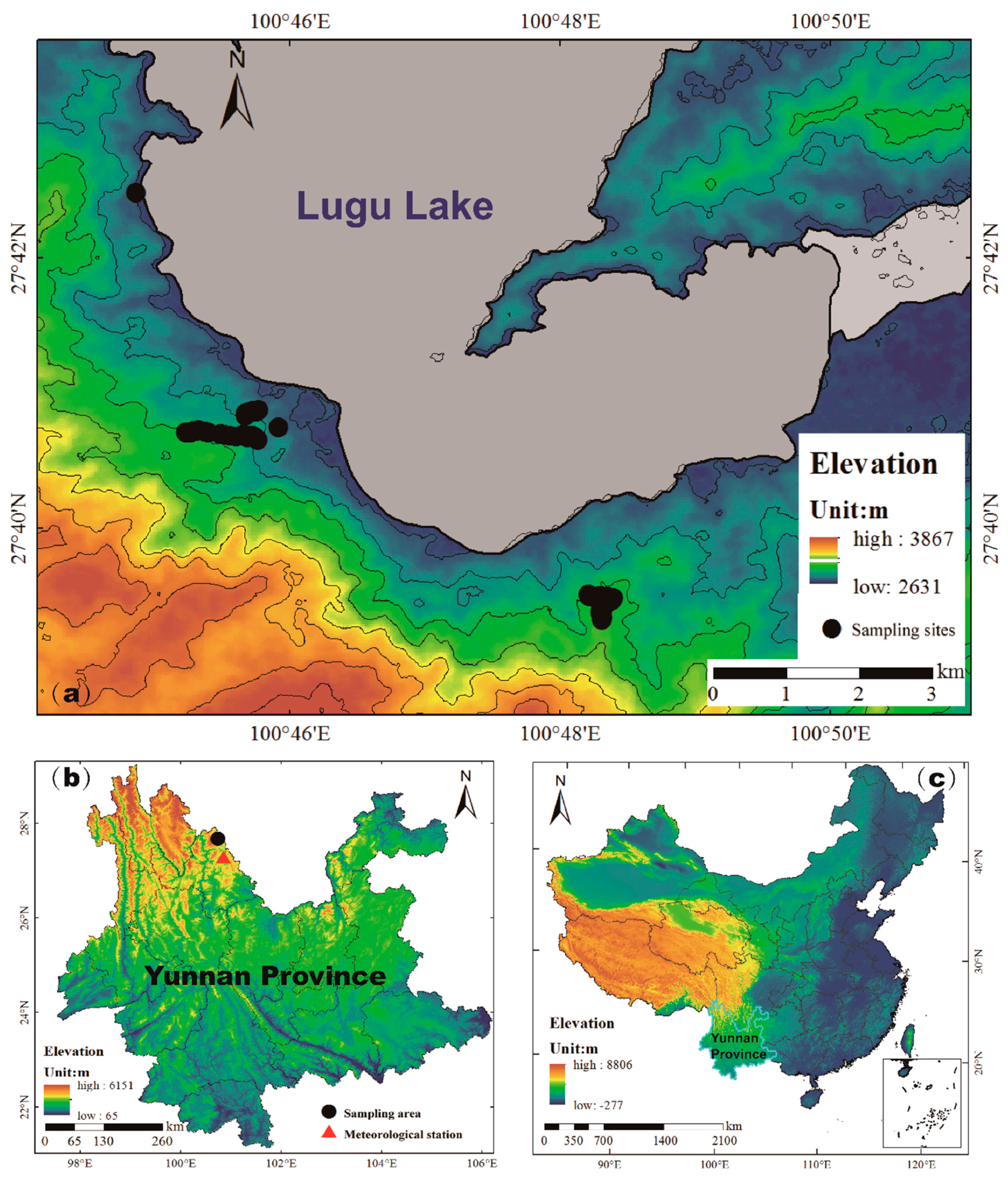
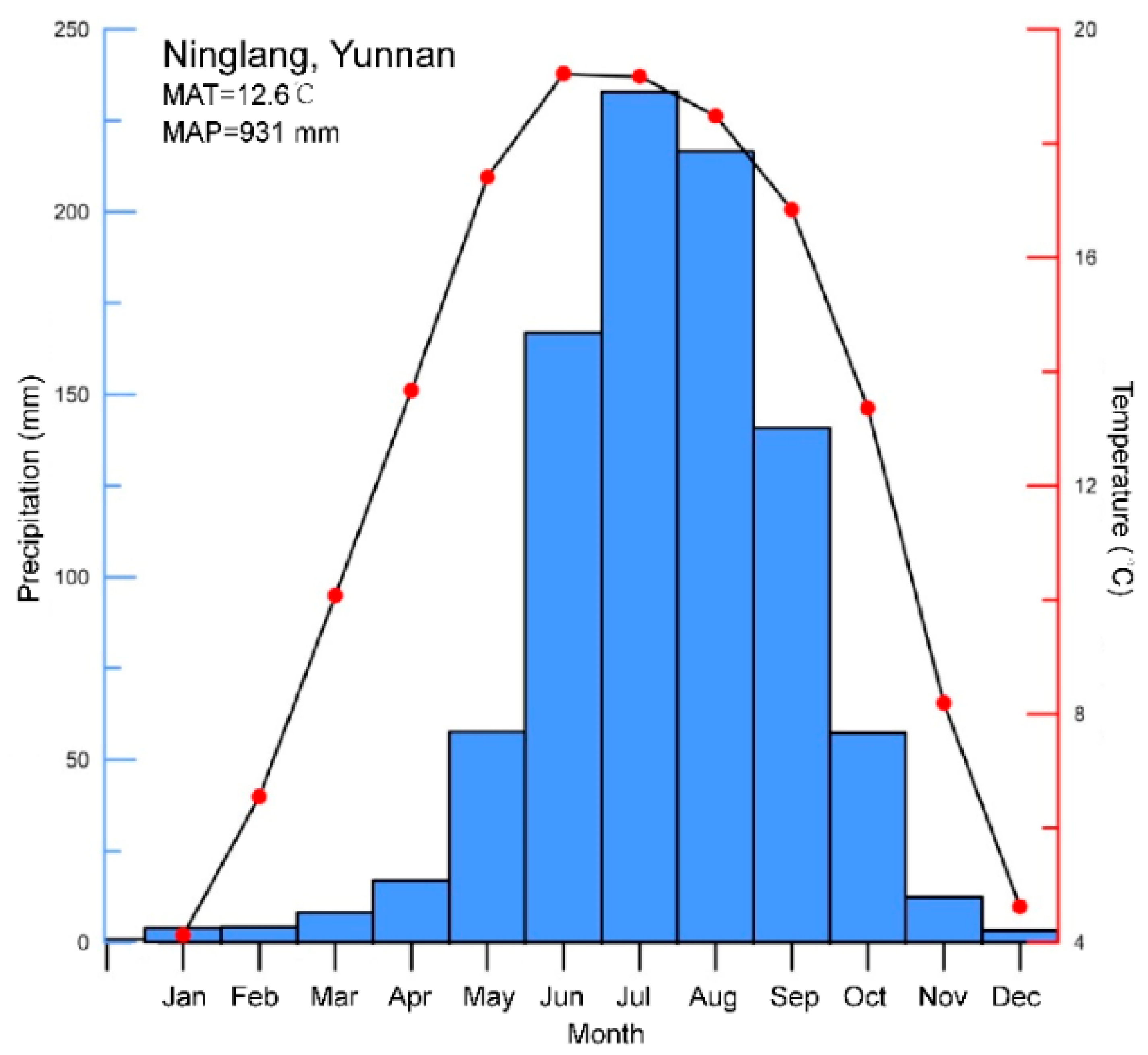
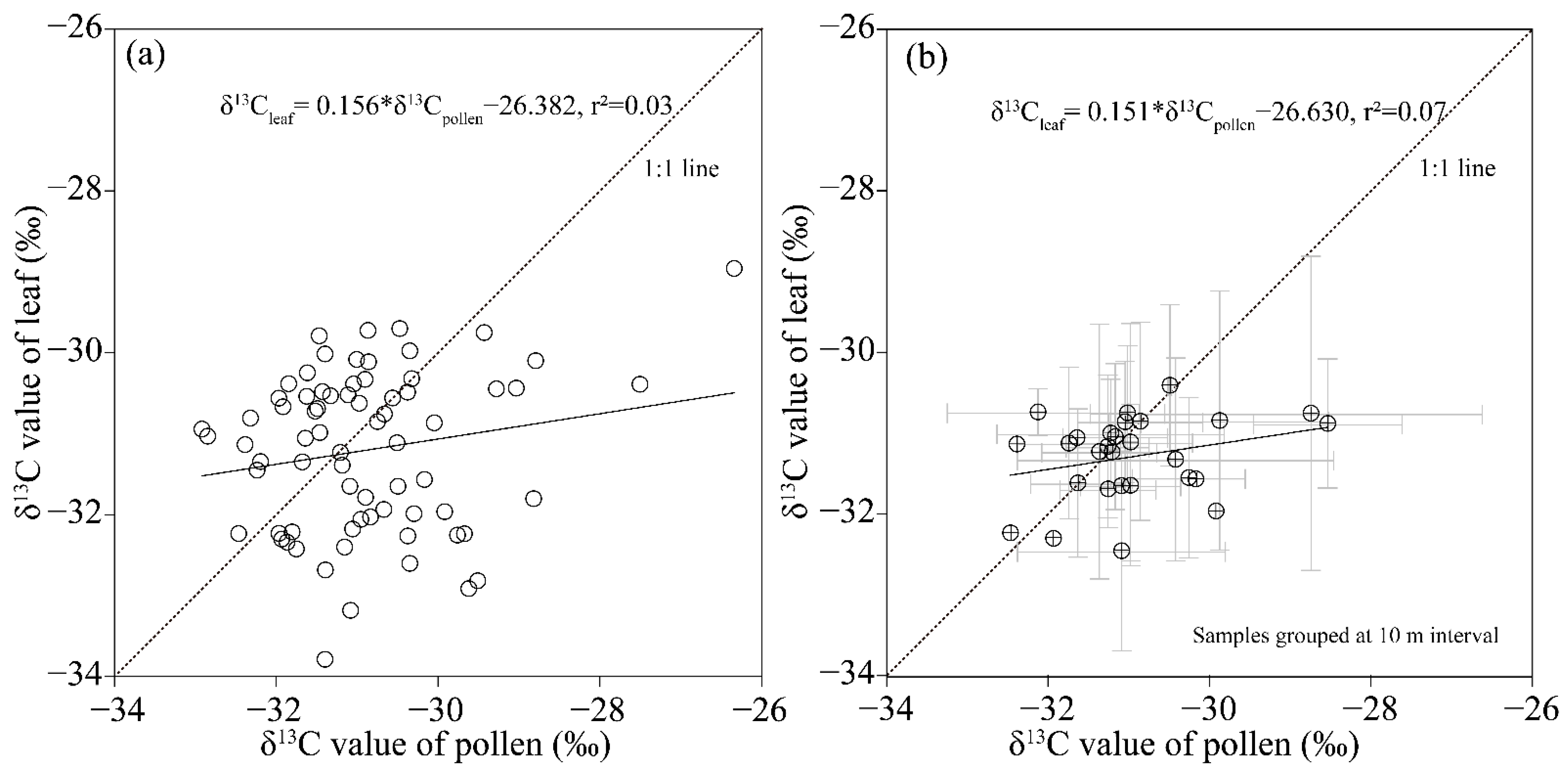
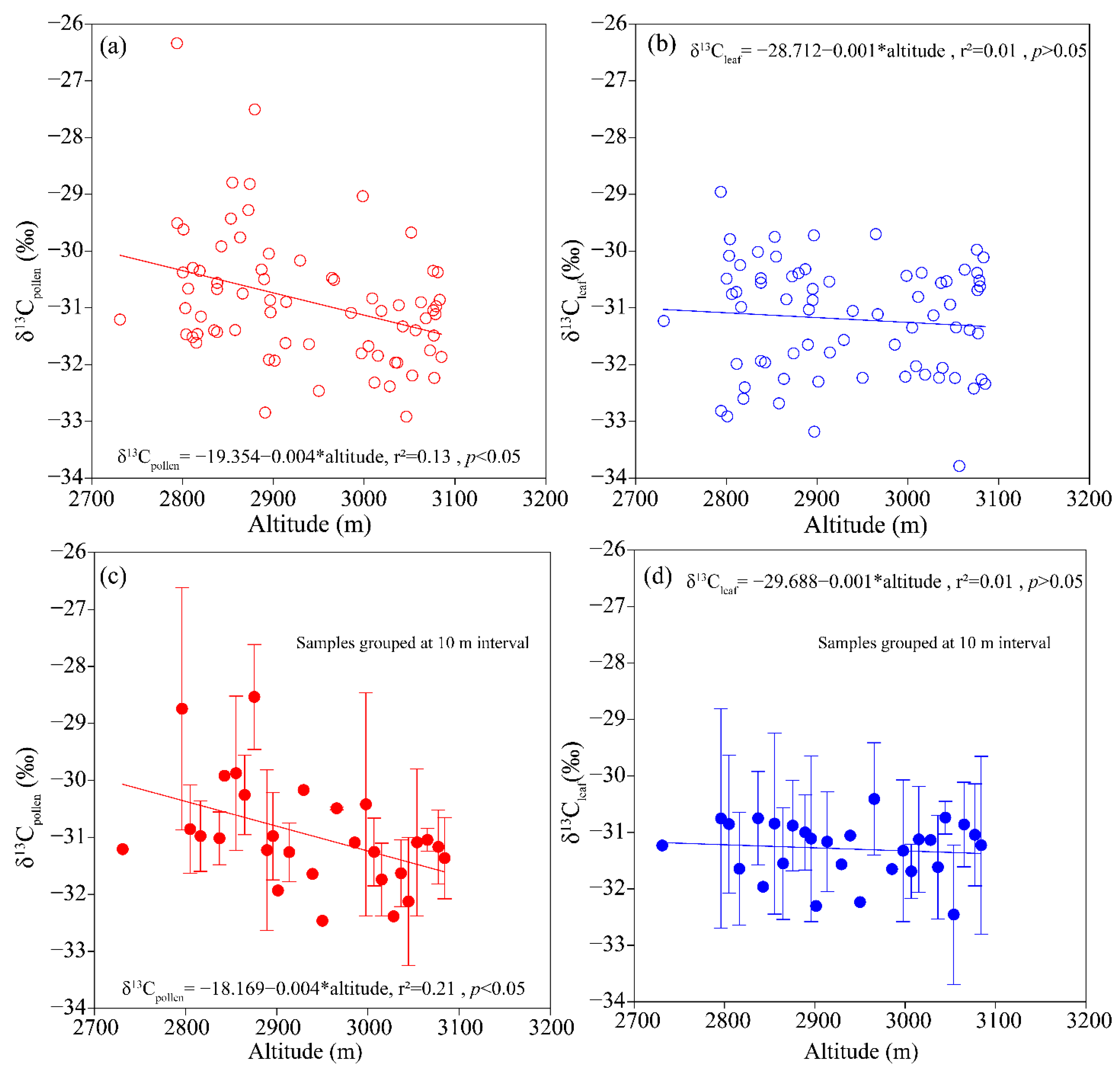
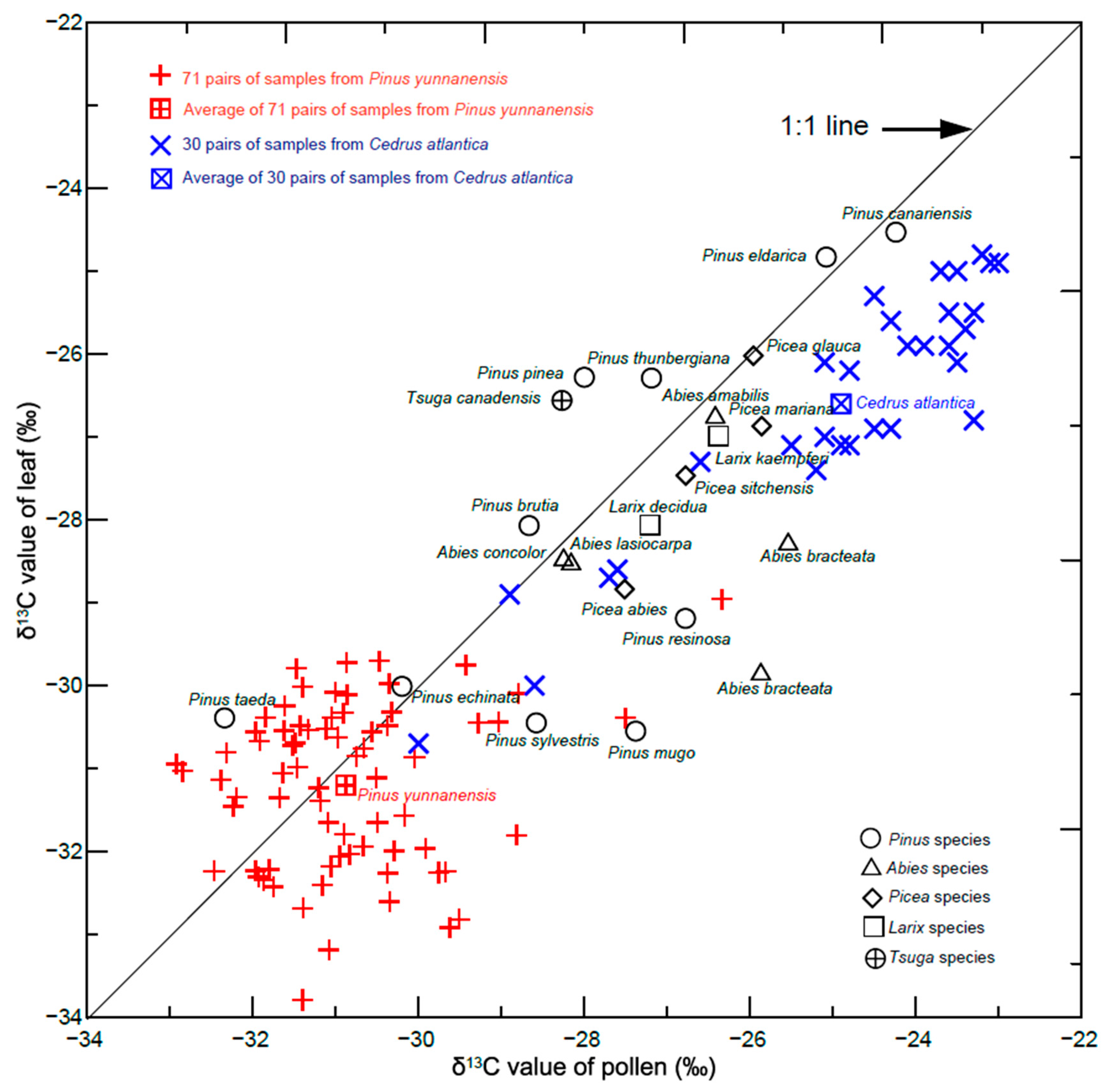
| Sample | Latitude | Longitude | Altitude (m) | Pollen δ13C (‰) | Leaf δ13C (‰) |
|---|---|---|---|---|---|
| LHL-01 | 27.7079 | 100.7477 | 2793.8 | −26.34 | −28.96 |
| LHL-02 | 27.6790 | 100.7653 | 2731.0 | −31.21 | −31.23 |
| LHL-03 | 27.6811 | 100.7626 | 2801.0 | −29.62 | −32.92 |
| LHL-04 | 27.6810 | 100.7624 | 2800.3 | −30.38 | −30.49 |
| LHL-05 | 27.6811 | 100.7623 | 2806.1 | −30.66 | −30.76 |
| LHL-06 | 27.6811 | 100.7622 | 2803.9 | −31.47 | −29.79 |
| LHL-07 | 27.6811 | 100.7622 | 2803.0 | −31.01 | −30.08 |
| LHL-08 | 27.6811 | 100.7622 | 2811.3 | −30.30 | −31.99 |
| LHL-09 | 27.6811 | 100.7621 | 2810.9 | −31.52 | −30.72 |
| LHL-10 | 27.6811 | 100.7621 | 2815.1 | −31.62 | −30.25 |
| LHL-11 | 27.6810 | 100.7621 | 2816.2 | −31.46 | −30.99 |
| LHL-12 | 27.6810 | 100.7620 | 2818.8 | −30.35 | −32.60 |
| LHL-13 | 27.6810 | 100.7619 | 2820.1 | −31.16 | −32.40 |
| LHL-14 | 27.6809 | 100.7615 | 2834.7 | −31.40 | −30.02 |
| LHL-15 | 27.6808 | 100.7614 | 2837.9 | −31.43 | −30.48 |
| LHL-16 | 27.6808 | 100.7614 | 2837.9 | −30.67 | −31.94 |
| LHL-17 | 27.6808 | 100.7613 | 2842.6 | −29.92 | −31.96 |
| LHL-18 | 27.6808 | 100.7612 | 2854.7 | −28.80 | −30.10 |
| LHL-19 | 27.6805 | 100.7612 | 2866.1 | −30.75 | −30.85 |
| LHL-20 | 27.6813 | 100.7628 | 2794.0 | −29.51 | −32.82 |
| LHL-21 | 27.6775 | 100.7627 | 2838.1 | −30.56 | −30.56 |
| LHL-22 | 27.6777 | 100.7625 | 2853.2 | −29.43 | −29.75 |
| LHL-23 | 27.6778 | 100.7625 | 2857.9 | −31.39 | −32.68 |
| LHL-24 | 27.6780 | 100.7622 | 2863.4 | −29.76 | −32.25 |
| LHL-25 | 27.6781 | 100.7621 | 2872.4 | −29.28 | −30.45 |
| LHL-26 | 27.6780 | 100.7620 | 2874.0 | −28.82 | −31.80 |
| LHL-27 | 27.6781 | 100.7618 | 2879.5 | −27.50 | −30.39 |
| LHL-28 | 27.6781 | 100.7617 | 2886.9 | −30.33 | −30.32 |
| LHL-29 | 27.6780 | 100.7616 | 2889.8 | −30.50 | −31.65 |
| LHL-30 | 27.6779 | 100.7614 | 2890.9 | −32.85 | −31.03 |
| LHL-31 | 27.6780 | 100.7613 | 2895.0 | −30.05 | −30.87 |
| LHL-32 | 27.6781 | 100.7609 | 2896.4 | −30.87 | −29.72 |
| LHL-33 | 27.6781 | 100.7606 | 2895.1 | −31.92 | −30.67 |
| LHL-34 | 27.6780 | 100.7600 | 2896.8 | −31.08 | −33.18 |
| LHL-35 | 27.6781 | 100.7593 | 2901.3 | −31.93 | −32.30 |
| LHL-36 | 27.6782 | 100.7587 | 2913.3 | −31.62 | −30.54 |
| LHL-37 | 27.6783 | 100.7581 | 2914.0 | −30.90 | −31.79 |
| LHL-38 | 27.6785 | 100.7566 | 2929.4 | −30.17 | −31.57 |
| LHL-39 | 27.6785 | 100.7562 | 2939.2 | −31.64 | −31.06 |
| LHL-40 | 27.6788 | 100.7553 | 2950.0 | −32.47 | −32.23 |
| LHL-41 | 27.6787 | 100.7552 | 2964.6 | −30.47 | −29.70 |
| LHL-42 | 27.6787 | 100.7549 | 2966.7 | −30.51 | −31.11 |
| LHL-43 | 27.6784 | 100.7544 | 2985.4 | −31.09 | −31.65 |
| LHL-44 | 27.6785 | 100.7538 | 2997.0 | −31.81 | −32.21 |
| LHL-45 | 27.6581 | 100.8066 | 3046.4 | −32.92 | −30.94 |
| LHL-46 | 27.6578 | 100.8064 | 3052.9 | −32.20 | −31.35 |
| LHL-47 | 27.6578 | 100.8062 | 3056.5 | −31.40 | −33.79 |
| LHL-48 | 27.6576 | 100.8059 | 3062.5 | −30.90 | −30.33 |
| LHL-49 | 27.6574 | 100.8058 | 3067.8 | −31.19 | −31.39 |
| LHL-50 | 27.6572 | 100.8057 | 3072.5 | −31.75 | −32.43 |
| LHL-51 | 27.6571 | 100.8055 | 3075.9 | −30.35 | −29.98 |
| LHL-52 | 27.6567 | 100.8053 | 3083.2 | −30.86 | −30.11 |
| LHL-53 | 27.6564 | 100.8052 | 3080.9 | −30.37 | −32.26 |
| LHL-54 | 27.6563 | 100.8052 | 3077.2 | −32.24 | −31.45 |
| LHL-55 | 27.6564 | 100.8050 | 3076.6 | −31.49 | −30.69 |
| LHL-56 | 27.6559 | 100.8052 | 3078.5 | −31.11 | −30.52 |
| LHL-57 | 27.6557 | 100.8053 | 3079.2 | −30.98 | −30.63 |
| LHL-58 | 27.6555 | 100.8052 | 3085.0 | −31.87 | −32.34 |
| LHL-59 | 27.6554 | 100.8053 | 3076.1 | −31.05 | −30.39 |
| LHL-60 | 27.6582 | 100.8060 | 3051.7 | −29.67 | −32.24 |
| LHL-61 | 27.6582 | 100.8054 | 3042.5 | −31.33 | −30.53 |
| LHL-62 | 27.6582 | 100.8051 | 3038.1 | −30.95 | −32.06 |
| LHL-63 | 27.6583 | 100.8051 | 3036.4 | −31.97 | −30.56 |
| LHL-64 | 27.6583 | 100.8049 | 3034.2 | −31.97 | −32.23 |
| LHL-65 | 27.6582 | 100.8042 | 3028.1 | −32.39 | −31.14 |
| LHL-66 | 27.6583 | 100.8039 | 3018.8 | −31.06 | −32.18 |
| LHL-67 | 27.6583 | 100.8039 | 3015.0 | −31.85 | −30.38 |
| LHL-68 | 27.6583 | 100.8037 | 3011.2 | −32.32 | −30.81 |
| LHL-69 | 27.6584 | 100.8036 | 3008.9 | −30.84 | −32.03 |
| LHL-70 | 27.6584 | 100.8036 | 3004.6 | −31.68 | −31.35 |
| LHL-71 | 27.6584 | 100.8036 | 2998.4 | −29.03 | −30.44 |
| Mean | −30.88 | −31.20 | |||
| Minimum | −26.34 | −28.96 | |||
| Maximum | −32.92 | −33.79 | |||
| Range | −6.58 | −4.83 | |||
| 1σ | 1.14 | 0.99 |
Publisher’s Note: MDPI stays neutral with regard to jurisdictional claims in published maps and institutional affiliations. |
© 2022 by the authors. Licensee MDPI, Basel, Switzerland. This article is an open access article distributed under the terms and conditions of the Creative Commons Attribution (CC BY) license (https://creativecommons.org/licenses/by/4.0/).
Share and Cite
Sun, W.; Shen, C.; Huang, L.; Meng, H.; Ren, B. The Stable Carbon Isotope Composition of Pinus yunnanensis Pollen and Leaf in Northwestern Yunnan, China. Forests 2022, 13, 1747. https://doi.org/10.3390/f13111747
Sun W, Shen C, Huang L, Meng H, Ren B. The Stable Carbon Isotope Composition of Pinus yunnanensis Pollen and Leaf in Northwestern Yunnan, China. Forests. 2022; 13(11):1747. https://doi.org/10.3390/f13111747
Chicago/Turabian StyleSun, Wenjun, Caiming Shen, Linpei Huang, Hongwei Meng, and Binbin Ren. 2022. "The Stable Carbon Isotope Composition of Pinus yunnanensis Pollen and Leaf in Northwestern Yunnan, China" Forests 13, no. 11: 1747. https://doi.org/10.3390/f13111747
APA StyleSun, W., Shen, C., Huang, L., Meng, H., & Ren, B. (2022). The Stable Carbon Isotope Composition of Pinus yunnanensis Pollen and Leaf in Northwestern Yunnan, China. Forests, 13(11), 1747. https://doi.org/10.3390/f13111747






